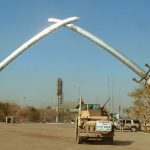
The Ukrainian capital of Kiev owes its location to the Dnieper River, much as the U.S. city of St. Louis exists because of the Mississippi. The Dnieper is the premier navigable river in the region – and the historical agricultural surpluses of the regions in and around Kiev made the region a prime target for Russian expansion. Kiev, in line with its position as capital and Ukraine’s largest city, has a large density of bridges capable of handling significant vehicular traffic from one side of the Dnieper to the other. Downriver, the number of significant bridge crossings drops precipitously as the river widens. If an outside power were able to seize the city – say, the Russians – it could effectively cut-off the eastern and western portions of Ukraine from each other. Similarly, Russian artillery, armor, and tanks need Kiev’s bridges to effectively move land forces westward in any conflict with Europe as a whole, a key reason Ukraine’s entry into the EU or NATO always has been a red line for Moscow. At nearly a mile long, the Paton Bridge is Kiev’s longest, forming a critical piece of transport infrastructure in a city that itself occupies a highly strategic location along one of eastern Europe’s most critical waterways.
For more on the future of Ukraine, see Chapter 6 of The Absent Superpower.



